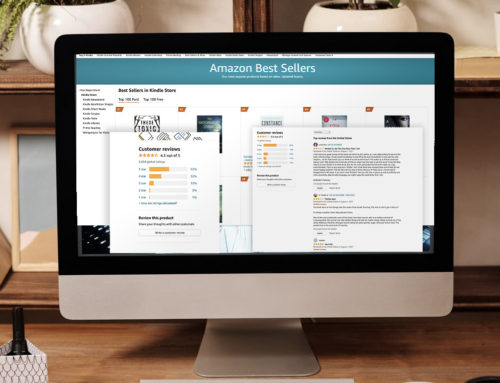 A while back, I had a debate with fellow Indie author, self-publishing zealot and Year Zero Writer, Jenn Topper, on the issue of distribution. Ever since, it’s been something that’s gnawed away at me.
A while back, I had a debate with fellow Indie author, self-publishing zealot and Year Zero Writer, Jenn Topper, on the issue of distribution. Ever since, it’s been something that’s gnawed away at me.
This piece came partly out of Marc Horne’s fantastic article about Feedbooks; partly it’s a crystallization of many of the articles I wrote at the end of last year; and partly it’s come out of the increasing comments I’ve had about putting my work on Amazon.
What I want to say in this article may only apply word for word to “indie or die” people like me (then again, romantic fic, historical fic, SF and erotica aside, self-publishing best suits the indie or die writer), but there are, I hope, a whole lot of transferables for any self-publisher.
The issue I have with most self-publishers I meet is simple. They haven’t distinguished between a marketing plan and a business plan. That is to say, they have lots of great ideas about how to sell the book they’ve written, but very few about how to make a career as a writer. If pushed, some think that the latter will follow like a glorious dawn from the former. Most haven’t really thought.
In brief, a marketing plan assumes the existence of a product, and seeks to sell it. A business plan sets out how to build the long-term success for a venture that has a register of assets, each one of which needs to be marketed. The difference is sustainability. A marketing plan will help you now. A business plan will help you over time, and will incorporate lots of different marketing plans.
The problem for the self-publisher is that the best marketing plan for your book may not be the same as those that fit within your business plan. The best marketing plan is always the one that fits in your overall business plan and it may NOT be the one that sells the most copies of THIS book.
So my first question is this. What do you want from your writing? Do you want to be a writer? For a living? One day? If so, you need a business plan.
So my second question is what’s your business plan? And selling lots of copies of this book, then lots of copies of your next book isn’t a plan, it’s an aspiration. The most common business plan for the self-publisher is to sell lots of copies so as to get picked up by a mainstream publisher. Fine, that’s a plan. I think for a whole lot of reasons it’s a bad one, but it IS a plan. I’m not going to deal with that here, because I’m not really interested in self-publishing as a means to an end. It’s not. It’s a great way to go in its own right. And sure as eggs are eggs, if you’re doing it FOR some other reason, you won’t give the thing itself your all.
Selling a gazillion copies so you can retire to the Riviera or live on the “how I did it” conference circuit is also a business plan. And one or two people will do it. But one or two people isn’t something to base your dreams on.
My business plan probably sounds very old-fashioned, but it’s very simple. I intend, eventually, to build a fanbase of people who love my work and are prepared to part with their money because they’re my fans. It sounds rather like Kevin Kelly’s 1000 true fans idea, which is rather unfashionable in literary circles (for some very poor reasons I don’t have time to go into here – but suffice to say the “people won’t pay for merch or live shows from writers is a MYTH perpetuated by lazy writers and those so arrogant or dilettantish they think they have a right to be paid for their hobby or have forgotten that storytelling is a communal activity). And that’s because it is. Maybe 1000 is on the small side, but the principle is sound. Gain a fanbase of loyal readers who love your work, and will happily pay for it.
Once you have identified the central goal of your business plan, question three is, what parts make up that whole? If you accept you are looking for loyal fans, those parts are fairly straightforward.
- Write something amazing that people will love. This is still the most important thing. You can sell 100,000 copies of book 1, but if it’s rubbish those 100,000 won’t buy book two, which makes the long term goal harder. MAKE IT SO YOU ONLY HAVE TO SELL TO THE SAME PERSON ONCE. And once you have, they will sell you to their friends.
- Find where your fans hang out, and hang out there. Don’t “sell” there. Hang out with them. This is about the fan-writer relationship. So you need to give, personally. But because you don’t need a fanbase of hundreds of thousands that’s not impossible.
- Write lots – true fans generate more true fans. Book one will sell book two and your fanbase will grow with minimal effort from you. Lots of books and a few fans is a more robust business plan than lots of fans and few books.
So where does Amazon fit? Well, the point is that it doesn’t. It doesn’t give me anything that I can’t do better by another means. And it DOES, given my readers are 18-35 year-old urban indie/alt lifestyle types lose me a lot of cred. I’ve had a lot of direct feedback that people love to buy my book from my website via print on demand, or they love that SKIN BOOK is knocked up by hand to look like a festival programme. The DIY, non-Amazon angle is part of what appeals to them.
Of course I’m not suggesting that every self-publisher scratch the ISBN from the back of their book and take it off Amazon – what you should do depends on many factors. The point is this – yes, you can get yourself a few hundred sales on the Kindle boards, but why? Is that an integral part of your business plan? Or is it just a marketing plan for the book in hand.
___
Dan Holloway is a founder member of Year Zero Writers, and curator of eight cuts gallery. Writer, blogger, journalist and live performer, he is the author of the novel Songs from the Other Side of the Wall, and most recently the collection of short stories and poems (life:) razorblades included.
Get an Editorial Review | Get Amazon Sales & Reviews | Get Edited | Publish Your Book | Enter the SPR Book Awards | Other Marketing Services






















I agree with everything here, and have to emphasize just how important this post is. Really great point about 1000 fans. Seth Godin also talks a lot about creating fans. Fans are loyal. They talk about you to others. And most of all, they are fans of you, not just of your books. Engaging with fans is rewarding. Authors who know how to engage their audience will do well, and their fans will love it to. It’s win-win all around.
I think you’re spot on – fans are loyal. I know I am to my favourite bands (I’ll buy anything and go to any gigs I can get tickets for) and my favourite writers (sometimes I’ll even buy different editions of the same book because the different covers are cool). Anyone can get a few hundred extra sales of a book by pushing and pushing; like anyone can get a few thousand more hits for their website wiuth stumbleupon, but as authors its our job to write something really good that people will want, not just to foist something upon them. It also makes you feel better in what you do if you go about it that way.
I remain really curious about authors’ experiences of “trading up” one’s readers in price paid for the first few books that were priced very low in order to begin building an audience. A number of writers have said that pricing their books under two dollars led many people to take a chance on a new writer. So far so good.
The change in Amazon percentages for higher priced books has also led to a number of writers to say that they expect to be able to raise their prices once they have found an audienhce for their work. Also a reasonable hope.
Alas, the plan breaks down for me at this point. Given human nature and the economy, it seems just as likely readers will either move to new cheap books, ($2 or less) and rather resent having to pay more after supporting a new author and helping him gain an audience.
Has anyone tried this price increase and found that it actually worked for them? With Konrath giving some of his books away for free, I am even more intrigued by the concept of financing books 2, 3, or more, by raising prices on the existing loyal audience. Sounds dicey to me, but hope springs eternal.
Any reports? My response to a sudden price jump for a favorite author’s books would be mixed, to say the least. I can wish it were otherwise, but it is, what it is.
Personally, I really don’t like the “trading up” idea. I much much prefer “freemium” (I wrote an article here:
http://loudpoet.com/2009/09/03/freemium-for-writers-is-two-debates/ )
I think suddenly starting to charge for what used to be free demonstrates a lack of integrity that goes against the grain of the 1000 true fans model – if that’s your plan you need to be clear from the start. I make my work available for free, and always will – but people who like it can pay either for a special ed ebook or for a paperback. Others make some of their work free so people can get to know them, then charge for other work. But changing model when you’ve got a fanbase is misunderstanding what you weree doing in the first place.
I don’t think people do resent paying for work they love – even if it’s free in other formats – I think people tend to use free to discover and pay to keep – and for me as an author I take the view that if I don’t write a good enough book for peole to want it as a keeper I kind of don’t deserve to be paid.
I’ve always thought it atrocious that the royalty was only %30, however when people were pricing their books at 0.99, that was the only way for Amazon to actually turn a profit on their works. It’s a cost of doing business, since all kindle owners get free 3G, and the cost of doing business. If it was %70 for a 0.99 book, that business model would fail.
Really, $2.99 and a %70 royalty is what the standards should have always been. It just took a while to implement. And lets face it: you’d have to sell 100,000 books on kindle per year at $.99 a piece to make $30k annually. Now, you only need to sell 15,000, which is actually doable.
That’s just to make a living. And everyone deserves to make a living doing what they love to do. It isn’t charity work. Yes, it is what we love to do, and only want to do. This makes it more feasible. That’s why everyone should expect good indie books to start at $2.99 – it’s a step towards making indie authorship worthwhile.
By the way, Dan’s point is absolutely right, still. Changing from “Free” to ANY amount of “Paid” is not acceptable. Once free, always free. However, Once at $2 does not mean always at $3. Otherwise we’d still be buying coffee for a nickel a cup. Freemium is a model all it’s own, but what I’m speaking about is only Amazon Kindle specific.
The marketing approach defined here is called branding. In this case, the author is the brand. It’s the glue that binds the publishing world together.
Higher pricing. I guess I fell into that when I moved popular titles from self-published offset books to self-published print-on-demand. I had to raise the list price in order to profit from the much higher unit cost. I masked some of it by moving from hardcover to trade paper, but the average POD trade paper ended up carrying a list price almost as high as the offset trade hardcover. I saw a drop in the rate of sales, but I didn’t have to sell off a 1,000-unit press run, so I think I’m ahead. I actually make a higher profit per unit, so it’s not altogether lost revenue, and some of these books have been continuously in print in one form or another for as long as twenty-five years.
Can a fiction writer pull it off? I think it’s possible only if you have a dedicated fan base or rise pretty high in a narrow genre. There’s a huge amount to be said for longevity, but you can’t plan that factor into the equation early in your career bid, you can obnly aspire.
I do agree that it’s easier for a non-fiction writer to self-publish than a fiction writer, although the latter can be done if the focus is tight enough. I disagree with the end point, though – I think you DO have to plan if not for longevity then at least for prolific output. It CAN be done through a one-off crossover breakout sensation, but following winds and favourable augurs aren’t the basis of a business model – a long, top notch backlist and expanding fanbase is.
Talking about writers and business plans in the same sentence makes me smile. The way I look at it, writers need to think of themselves as entrepreneurs worthy of investment. Entrepreneurs know that an investor – a bank or perhaps a group of individuals – looks to the business plan for assurance that a given service or product will succeed and deliver a sound return on investment. As writers we invest our time, energy and, in many cases, forgone income to the task of creativity. Submitting to the discipline of entrepreneurial thinking will enhance our efforts.